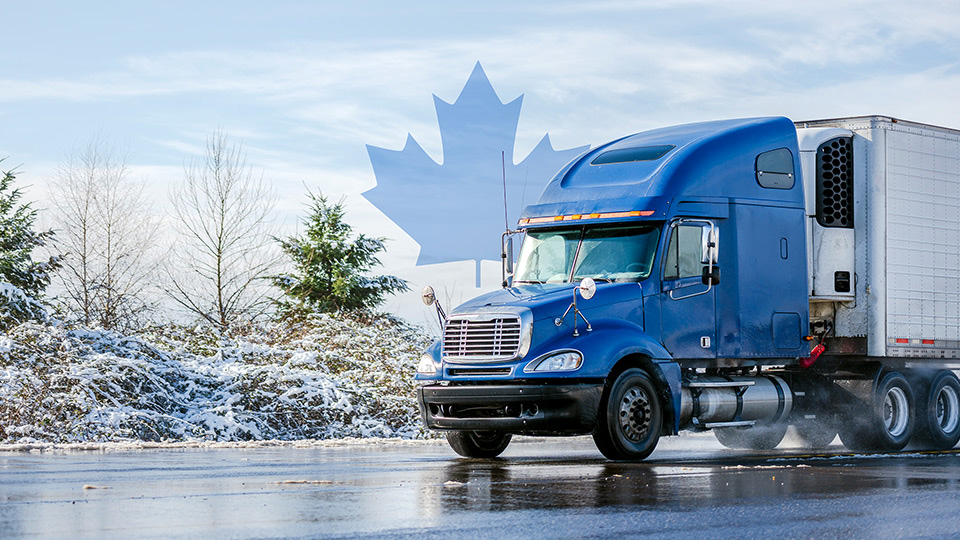
Telematics for winter operations: How Massachusetts DOT balances safety, efficiency & sustainability

Table of Contents
- Why salt is the material of choice in winter operations
- 5 types of material used to treat roads for snow & ice
- Why winter operations leaders are working to reduce salt usage
- Finding solutions to the road salt problem
- Tackling the road salt problem with telematics: Learning from MassDOT
- Conclusion
- Geotab for Winter Operations
The demands on today’s winter operations fleet managers are intense. Keeping the roads clear is a huge task in itself. Safety is the first priority, but environmental compliance is an increasingly important part of the job. Then there’s the ongoing need to manage operational costs. It’s a complex balancing act. But with the latest fleet technology, including telematics, it’s possible.
Telematics enables fleet managers to monitor fleet health, efficiently dispatch vehicles, strengthen compliance and accountability and monitor material usage. Together, these capabilities help ensure the roads get cleared while meeting environmental and cost-related mandates.
One large Department of Transportation in the northeastern U.S. is in the vanguard of efforts to leverage innovative fleet technology in winter operations. This paper will examine how the Massachusetts Department of Transportation (MassDOT) is using telematics paired with Automatic Vehicle Location (AVL) and GPS equipment to tackle one of the central challenges confronting winter operations professionals: monitoring and reducing road salt usage.
Why salt is the material of choice in winter operations
Road salt has been used in the U.S. since 1938, starting in New Hampshire. It quickly became the material of choice for de-icing due to its wide availability and low cost. But by the 1970s, transportation agencies began to recognize that using large quantities of road salt could harm the environment.
Still, its use and acceptance in snow belt regions increased quickly – doubling since 1975. This steep upturn corresponds with the expanding number of roadways requiring winter maintenance, but also rising expectations. Residents want and expect year-round road access, while emergency and service vehicles need it.
With these pressures in play, it’s unlikely that winter operations professionals will stop using salt in the foreseeable future – though they’re using alternate materials [see table] whenever possible. In a time of accelerating environmental degradation from many sources, however, there’s widespread recognition in the field that it’s more important than ever to monitor and decrease road salting.
5 types of material used to treat roads for snow & ice
1. Rock salt
Pros: Breaks up ice and prevents it from sticking to roads
Cons: Can harm the environment, doesn’t work well at lower temperatures
2. Liquid magnesium chloride
Pros: Prevents snow and ice from sticking to roads, inexpensive, works at lower temperatures, less harmful to the environment
Cons: Less effective in sub-freezing temperatures
3. Liquid Brine
Pros: Prevents snow and ice from sticking to the pavement, inexpensive
Cons: Doesn’t work well at extremely low temperatures
4. Sand
Pros: Increases traction at lower temperatures, inexpensive
Cons: Doesn’t melt snow and ice, can clog drains, must be removed and disposed of
5. Pre-mix (rock salt and calcium chloride)
Pros: Less harmful to the environment, works at lower temperatures
Cons: Expensive
Why winter operations leaders are working to reduce salt usage
The U.S. uses up to 32 million metric tons of salt each year to keep roads free of snow and ice for drivers. Multiply even a fraction of this amount by the 80-plus years salt has been used, and the number is staggering.
It’s important to note, though, that road salting is not the only contributor to salt in the environment. Acid rain and industrial activity such as mining and oil and gas extraction also release salt.
When salt from any source accumulates in soil and waterways, its adverse effects continue for many years. Even if salt usage dramatically declined immediately, the legacy impact would continue. Increasing salt concentrations in freshwater today may be the result of salt from decades ago spreading into groundwater and only now reaching surface waters.
A 2018 study on freshwater salinization syndrome found that 37% of the drainage of the contiguous U.S. has experienced an increase in salinity over the past 50 years. The degree of pollution in freshwater bodies depends on the amount of runoff, which varies based on diverse meteorological and topographical factors. Over time, however, the accumulation of salt presents risks to both human health and ecosystems.
1. Human Health
Groundwater contaminated with excess salt often makes its way into public water supplies. On the mild end of potential human health consequences, people may experience dry skin and eye irritation. Yet the most serious consequence by far is high sodium intake.
As sodium levels in drinking water exceed the World Health Organization (WHO) recommended salt concentration of no more than 200 mg per liter for drinking water systems, water consumption can measurably increase people’s overall sodium intake. For those on low-sodium diets due to cardiovascular or kidney disease, the potential consequences are serious.
2. Ecosystem health
Trees and plants near roads get exposed to salt via direct spray or root absorption. The evidence is often plain to see, with browning vegetation alongside many highways.
When sodium compromises waterways, it affects their ability to support plants and wildlife. High sodium concentrations are lethal to most amphibians, for example, but even sub-lethal sodium levels can impair the health, behavior and reproduction of many organisms.
Chloride, the other component in salt, is also toxic to aquatic life. A U.S. Geological Survey study found that chloride levels increased substantially in 84% of urban streams between 1960 and 2011. Together, sodium and chloride runoff can throw entire ecosystems off balance.
Finding solutions to the road salt problem
Winter operations fleet managers are working hard to reduce road salt’s harmful effects by implementing best management practices that closely monitor and restrict its use, including these strategies:
- Protecting environmentally sensitive zones
Identify the sensitive regions on road salting routes and leverage every possible method to mitigate contamination, from using alternative de-icers to reducing application rates. - Refining material distribution
Use tools that enable accurate and efficient salt application, such as automatic spreader controls. Make fine adjustments to application rates and keep track of total distribution. - Tracking temperatures and conditions
Use pavement temperature sensors to determine whether frozen precipitation will stick to the road. This information should guide salt application. - Using anti-icing methods
Before storms, use an anti-icing technique such as applying a brine solution to the roads. Research estimates this pre-treatment can yield a 75% reduction in total salt applied. - Pre-wetting roads
Spray brine on dry salt as it’s discharged from vehicles. Salt will stick better to the roads and minimize bounce, reducing salt infiltration to aquifers up to 5%. - Improving housekeeping
Take every measure to avoid releasing salt into the environment: improve salt storage, ensure proper spill clean-up and implement better disposal practices for treated snow. - Educating and training personnel
Provide regular training for all winter operations workers to ensure everyone is up to speed on best management practices for road salt application.
Even with strict adherence to best practices, some salt contamination inevitably occurs. Remediating new and legacy pollution is the final key piece in the overall strategy. There are several proven techniques to reduce or remove salt from soil and water.
Tackling the road salt problem with telematics: Learning from MassDOT
Up to 4,000 MassDOT Highway Division Snow and Ice Removal crews are responsible for keeping almost 16,000 lane miles of state roadway and nearly 5,000 bridges clear. It’s a massive undertaking in one of the country’s snowiest states.
MassDOT has been concerned about salt usage for several decades, but in 2011 the department formalized its efforts to reduce salt usage by implementing several best management practices:
- Pre-treating roads for snow events with anti-icing materials
- Pre-wetting salt with magnesium chloride
- Requiring closed loop material controllers on vehicles
The department’s investment in AVL and GPS equipment, along with an advanced telematics solution, has also been central to MassDOT’s commitment to maintaining safe roadways with the least salt possible. Depot personnel can see which routes have been tended over recent timeframes, for example, then decide if or when subsequent applications are necessary based on precipitation rates and types.
Combining best management practices with a GPS/AVL solution has enabled the department to use less salt today than prior to 2011 during winters of similar severity. They’re finding ways to balance safety, operational efficiency and sustainability using the following strategies:
1. Mapping environmentally sensitive areas
There are many areas of ecological significance near Massachusetts roadways. Some are officially designated Areas of Critical Environmental Concern, or ACECs. The 30 ACECs in the state, encompassing a total area of approximately 268,000 acres, have higher environmental protection regulations.
Kampoosa Bog, for example, has been the subject of several studies investigating the potential effects of road salt application on plant and animal life. The bog is adjacent to the I-90 and includes approximately 1,350 acres of wetlands, groundwater and rare species habitats. This ACEC also includes highly significant archaeological resources.
MassDOT created a salt sensitivity mapping tool to clearly identify which stretches of roadway border on environmentally sensitive and/or protected areas. “This automation helps ensure our operators use the appropriate materials in the appropriate amounts in these areas,” says Mark Goldstein - MassDOT Highway Operations. “This accuracy is critical for maximum environmental protection.”
2. Fine-tuning material application and tracking
MassDOT’s standard road salt application is 240 pounds per lane-mile, which is considered to be on the lower end of what’s needed to prevent snow and ice from sticking to the pavement under most conditions (especially when the pavement temperature ranges between 20 F and 30 F).
To gain deeper insight into exactly how much anti-icing and de-icing material each vehicle and fleet uses, MassDOT installed material tracking tools on vehicles in depot locations near environmentally sensitive areas.
The closed loop controllers on material spreaders deliver valuable information such as solid application rates, liquid application rates, solid total accumulated, liquid total accumulated, solid material type used and liquid material type used. “With these fleet metrics, we can make more informed decisions to help safeguard roadways and nearby waterways, plants and animals,” says Mark Goldstein - MassDOT Highway Operations.
3. Measuring temperature and conditions
Fleet managers consider several factors when deciding which anti-icing and de-icing materials to use. In the past, they could only access the basics, such as pavement temperature and air temperature. Now, with an advanced telematics solution integrated with multiple sensors, they can easily access more granular information such as:
- Precipitation type and intensity
- Road conditions, such as height of ice and/or snow
- Dewpoint
- Frost point
- Road grip
- Road geometry (slopes, curves, etc.)
This expanded insight further increases their ability to make data-driven decisions.
4. Employing alternative materials and methods
Armed with the important metrics from their telematics solution, MassDOT winter operations fleet managers use the anti-icing and/or de-icing methods that are most effective for clearing the roads and least damaging to the environment. One of their main strategies is pre-treating and pre-wetting techniques using corrosion-inhibited magnesium chloride to reduce the overall application of salt.
The only times MassDOT fleet managers use sand to treat the roads is in hilly terrain, where traction is paramount, and in some environmentally sensitive areas. In both instances, they use a one-to-one mix of salt and sand.
The department uses sand sparingly because environmental regulations require that all sand must be retrieved – pound for pound – at the end of the winter season. It’s a laborious, costly task, especially when sand gets in the catch basins.
5. Assessing performance and operations in real time
Before MassDOT implemented a telematics solution, they relied on reports from contractors to determine operational efficiency in areas such as mileage, vehicle performance and route completion. “We found the results were often inconsistent and difficult to confirm,” says Mark Goldstein - MassDOT Highway Operations. “This lack of data reliability held us back in trying to improve efficiency and sustainability.”
Now, fleet managers can access live service maps to view real-time route completion tracking. The GPS/AVL equipment delivers data that can be used as performance metrics, such as the amount of time spent to complete routes and how road conditions, locations and orientation affect plowing and material application times.
“Now we can see the precise location of fleets, measure vehicle performance and evaluate operator behavior,” says Mark Goldstein - MassDOT Highway Operations. “All of this information helps us optimize performance and manage operating costs.”
6. Capturing critical data for compliance and accountability
Winter operations fleet managers must answer to multiple overseers – from departmental directors to environmental regulators. Each of these stakeholders is looking for different kinds of evidence that fleets are meeting their obligations: to clear roads in a timely way, operate efficiently and within budget, and minimize the negative effects on the environment.
With telematics data, MassDOT winter operations can quickly and easily demonstrate its performance in each area of concern. For example, telematics makes it simple for the department to provide detailed salt usage reports in order to meet environmental compliance targets. At the end of each season, MassDOT can accurately account for how much, where and when it used salt in every area where the fleets are equipped with telematics.
7. Investing in training and coaching
MassDOT is a large, dispersed operation. Approximately 775 employees work with 1,200 contractors, who have 3,300 pieces of equipment. The department expects 100% compliance from employees and contractors when it comes to safety, efficiency and sustainability. To ensure everyone is on the same page, the department runs regular snow and ice training emphasizing adherence to best management practices for material selection and application, proactive operations, housekeeping and salt storage.
One key aim in all the training and education programs is to increase awareness of the environmental impact of snow and ice clearing. There are always discussions on the negative consequences of road salt accumulating in environmentally sensitive areas, and what operators and managers can do to mitigate the harm.
The real-time visibility provided by telematics is an important coaching tool not just in formal training programs, but year-round. For example, fleet managers can show operators exactly how well they’re complying with requirements for material application specified in the salt sensitivity mapping tool. The telematics data empowers fleet managers to deliver immediate feedback to employees and contractors, so operations can constantly improve.
Conclusion
Salt will be used to clear roads for the foreseeable future, yet it’s possible to reduce its environmental impact. As MassDOT has shown, combining best management practices with the latest fleet technology can help balance safety, efficiency and environmental responsibility.
Geotab for Winter Operations
Geotab’s Public Works solution simplifies and modernizes fleet management, enabling improved productivity, efficiency and environmental compliance in winter operations. State, provincial and local governments trust Geotab to manage their maintenance fleets.
The Geotab advantage offers winter fleet managers:
- Active tracking of maintenance vehicles
- Real-time reporting on salt usage
- Automated reporting for regulatory compliance
- Real-time visibility on operator performance and current state of snow removal
- Actionable insight for preventive maintenance
All the crucial real-time information fleet managers need can be accessed on a single, user-friendly platform.
Post Tags
About Geotab
Geotab is a global leader in connected vehicle and asset solutions, empowering fleet efficiency and management. We leverage advanced data analytics and AI to transform fleet performance, safety, and sustainability, reducing cost and driving efficiency. Backed by top data scientists and engineers, we serve over 55,000 global customers, processing 80 billion data points daily from more than 4.7 million vehicle subscriptions. Geotab is trusted by Fortune 500 organizations, mid-sized fleets, and the largest public sector fleets in the world, including the US Federal Government. Committed to data security and privacy, we hold FIPS 140-3 and FedRAMP authorizations. Our open platform, ecosystem of outstanding partners, and Marketplace deliver hundreds of fleet-ready third-party solutions. This year, we're celebrating 25 years of innovation. Learn more at www.geotab.com and follow us on LinkedIn or visit Geotab News and Views.
© 2025 Geotab Inc.All Rights Reserved.
This white paper is intended to provide information and encourage discussion on topics of interest to the telematics community. Geotab is not providing technical, professional or legal advice through this white paper. While every effort has been made to ensure that the information in this white paper is timely and accurate, errors and omissions may occur, and the information presented here may become out-of-date with the passage of time.
Recent News

4 ways to unlock the power of quality data
June 30, 2023


Your comprehensive guide to the Canadian ELD mandate
May 16, 2022

Putting fleet data quality to the test for risk management
March 25, 2022